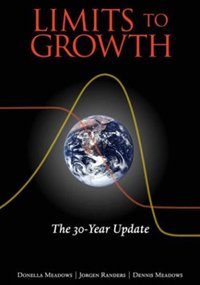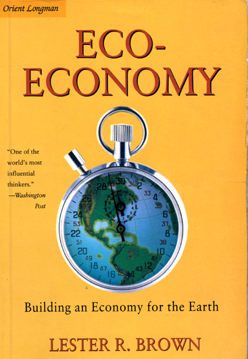 |
 |
 |
 |
| Volume
3 - Issue 12 DECEMBER 2005 |
|
Return to the Feature: God, Man And Water THE CLUB OF ROME REPORT Computer simulation is a methodology in which the mathematician turns computer scientist. Applied mathematicians love to describe the real world in terms of models. A model is a mathematical representation of phenomena, both natural and relating to Society. Take for example, the weather. In India, long before the season, people are anxious to know what might happen during the forthcoming monsoon. Meteorologists try to forecast this using a computer model for the monsoon. To work the model, inputs are needed. The Mets feed in all kinds of observations accumulated from the pre-monsoon season like surface temperature at different parts of the seas surrounding India, the land temperatures, the wind speeds observed at various altitudes, the atmospheric pressures at different places and different heights, etc. The computer is then allowed to roll and the results it churns out are the predictions of the model, for the input conditions specified. How good is this approach? Well, basically, it depends on two important factors. 1) The quality of the model itself, and 2) the accuracy of the input data. Often the starting models are imprecise but almost invariably, most models get refined over a period of time, after which, with good input data, they make fairly good predictions. Computer simulation is now a discipline in itself and is widely used in wide-ranging branches of science – from astrophysics to molecular biology, ecology, and even economics. Forrester’s study was based on a model of world growth he had constructed. Professor Forrester’s report contained three main conclusions:
Limits to Growth gave mankind the unpleasant message that the world was heading for disaster because of unfettered population growth, reckless industrial expansion, exhaustion of stocks of natural resources, environmental destruction, and food shortages. Understandably, Forrester’s report became the subject of heated controversy, and the Club of Rome soon gained the reputation of being a neo-Malthusian movement of doomsayers. In any event, the report became world famous. Since 1972, countless experts have revisited the subject, and any number of books have been published. We obviously cannot go into all that here but might mention the three basic viewpoints that have emerged. The first is by people using the tools of simulation and what they believe to be better and more accurate models. They essentially confirm the predictions of Forrester, though the details might vary. The second is by experts who have great faith in man’s ability to overcome obstacles through ingenuity. One of these is Herman Kahn, hailed as a great Think Tank expert. Kahn does not use a mathematical model but a logical model of human behaviour. In effect he says, necessity is the mother of invention, and that man can and will surely devise means to overcome all obstacles. In other words, Kahn has faith in technology and its ability to solve problems, however knotty they might be. In the years that followed Kahn’s study, many have gone further to actually script how technology can save the day. One of these is Lester R. Brown, Founder of the Earth Policy Institute, and the winner of innumerable awards. Brown has outlined the future in his book Eco-Economy. He analyses the present and concludes that all our problems are due to the use of wrong technologies and wrong practices, all of which harm the eco system. If we switch to eco friendly technology and careful recycling, then all would be fine and there can be no disaster in the future. The third viewpoint is that of James Lovelock, an English scientist. Called the Gaia hypothesis after the Greek concept for Mother Earth, Lovelock’s view of the world suggests that the earth is a living organism with a complex feedback system that seeks an optimal physical and chemical environment. What Lovelock says is essentially the following: If growth proceeds as at present, Nature would intervene in her own way, perhaps via disasters of various kinds, to limit the population and to inhibit man progressing as now. In other words, mankind would take a step backward, have less population and less technology as a result of which some kind of stability would be restored, though with a much lower standard of living. In essence, according to the Gaia hypothesis the planetary environment is a self-regulating process. Given below is a graph that captures the essence of the doomsday picture.
A few comments now on the above. All the various studies quoted above are no doubt well motivated and thorough in their own respective ways. Of these, models like that of Forrester reduce man to a thoughtless consuming machine. Kahn and Brown, on the other hand, argue that man is an intelligent consuming machine. If he finds that his present style is damaging, he would invent another that is not damaging. He does not necessarily have to compromise on his present standard of living, at least not too much. Lovelock seems to feel, perhaps with good reason, that man might be very smart in a worldly sense but is otherwise a fool and headed for a crash. Nature will allow the crash to happen, and throw man back to a more primitive existence for restoring balance. If we look at the different views summarised above, one thing that is common is that all the analyses have been made by experts in the West, and it would seem that their proto type man is essentially a Westerner, both in style and in attitude. Secondly, human nature is not explicitly taken into account. It is sort of assumed that man is driven by the Mind. This may be a fact of daily life but one cannot totally ignore that man, as Swami always reminds us is Soul first, Mind next and body last. This being the case, it is wrong to keep the Soul out of any discussion relating to mankind’s future. Maybe the mathematician can ignore the Soul in making weather forecasts, but is that legitimate in this case? This is where our thinking differs, as we point out in the main text. Basically we say, man has Buddhi (intellect). If only he activates it, he does not have to face disaster and slide back into primitive existence as Lovelock thinks he might. The disaster has not yet happened and we can stop it even now; only we must use Buddhi and not Medha Shakti or worldly intelligence alone. The Club of Rome prediction applies to mankind that chooses to ignore Buddhi. As Krishna has clearly stated, if Buddhi is allowed to rust then disaster is certain. But if Buddhi is allowed to guide, then there is no need for any fear. Return to the Feature: God, Man And Water
|
| You can write to us at : h2h@radiosai.org |
Vol 3 Issue 12 - December 2005
|
Best viewed in Internet Explorer - 1024 x 768 resolution. |
DHTML Menu by Milonic. |
 In 1972, a report was published by a “club” nobody had ever heard of, which shocked the world. This report, which was all about the forthcoming collapse of life on earth, was written not by some doomsday prophet but by scientists of high repute, led by a M.I.T professor named Jay Forrester. The report was called Limits to Growth, and based on the results of a computer simulation of what the future of the world would be, if it went on at the rate prevailing then, i.e., 1972.
In 1972, a report was published by a “club” nobody had ever heard of, which shocked the world. This report, which was all about the forthcoming collapse of life on earth, was written not by some doomsday prophet but by scientists of high repute, led by a M.I.T professor named Jay Forrester. The report was called Limits to Growth, and based on the results of a computer simulation of what the future of the world would be, if it went on at the rate prevailing then, i.e., 1972. 



